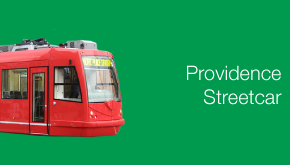
RIPTA and the City of Providence will be holding public meetings this month on their “Circulator” Providence Core Connector Study project, you may know the Providence Core Connector better as the streetcar line proposed in the Metro Transit Study.
These meetings will be looking at options for making mass transit connections between the Brown University area, the Providence Train Station, and the Hospitals in Upper South Providence. The goal will be to come up with what is known as a “Locally Preferred Alternative” which will then be the basis of applying for federal funding.
The Metro Transit Study of course recommended streetcars, the current Mayor wants streetcars, and I think most of our readers want streetcars, but we do have to go through a public process and assess all options. So these meetings will be looking at what mode should be used to make this transit connection, and what route said mode should take.
The public meetings are scheduled for:
- College Hill Open House
Tuesday, Sept. 21, from 5-7pm.
Brown RISD Hillel Center, 80 Brown Street
Informal drop-in open house, with brief formal presentation at 6pm - Upper South Providence Open House
Wednesday, Sept. 22, from 5-7pm
Edmund Flynn Elementary School, 220 Blackstone Street
Informal drop-in open house, with brief formal presentation at 6pm - Downtown Open House
Thursday, Sept. 23, from 12:30-2pm
The Commerce Center, 30 Exchange Terrace
Informal drop-in open house, with brief formal presentation at 1pm




The more I think about the proposed route the more opposed I become toward it. It makes no sense in that it serves the interests of Brown University Medical School more so than the city as a whole.
I think better routes might connect the western end of the city (Olneyville) to perhaps the northern end. Both are areas that are rather impoverished.
But the north end is interesting. I can see a line run down Charles St, or even Branch Ave connecting into downtown Providence to the western arm.
Rather than opposing the entire project because of one interest, Brown, it would be more positive to advocate or insist on extending one line to Olneyville. When the Transit 2020 group initially proposed routes there was one north south and another east west. Adding a western leg would conform to the original concept and could reinforce RIPTA’s plan to create sub-hubs for the bus system, assuming that the line went along Westminster Street through Hoyle Square.
The Transit 2020 study group likely dropped the proposed western route for cost reasons. Streetcars would not be allowed to travel over 95 because overhead wires (the catenary) are not permitted over any Interstate highway. There is a more expensive solution to this problem that was developed in Europe. The power source is located in the street bed rather than overhead. The imbedded “third rail” is only energized when the train is directly over the rail. Another reason would be that RIPTA would have to hire more streetcar operators (or drivers) to keep reasonable schedule headways and to reduce wait times for changing lines.
The reality is that greater Downtown desperately needs a frequent internal transit system. For the Warwick/South County commuter rail service to work at all in Providence, the entirety of Greater Downtown’s commercial, industrial, and institutional districts require transit interconnectivity on short headways. Nothing remotely like this exists today. College Hill, and Hoyle or Olneyville Squares are logical extensions of Downtown for initial service due to the large non-residential populations that work or study at those locations.
The most viable new industry in the city is the medical bio-tech field, which in part is why Brown is such a focus. Brown is not the only reason the city needs this project, but it’s an important component.
Interesting problem regarding catenary over 95. When was such a thing outlawed? And why? Given this fact, is it safe to assume that nobody west of 95 (most of the city’s poor people) has any hope of seeing a streetcar line happen in the foreseeable future?
When the federal government wrote the law enacting the Interstate Highway system in the 1950s.
Is this law for overhead wires just for streetcars over I-95, since the under construction DC Streetcar network will take it over I-295 on Benning Rd, and since most light rail systems travel over Interstates?
Also, I would think that the power source in the street wouldn’t work well for our winters, and I hear that there is some research going into battery storage for segments of routes that can’t use overhead wires .
And this is a starter line that will hopefully grow to serve the west side, although there should be some sort of full vision, with a phased approach.
I don’t think catenary can not be placed over a bridge over an interstate, I think they can’t be placed directly over an interstate lane itself. That is why the Airport Silver Line in Boston is a hybrid. They could not run catenary through the Ted Williams tunnel because it is Interstate 90.
I can’t off the top of my head think of anywhere where catenary actually runs over a bridge over an interstate, the Acela must cross an interstate somewhere. Also, the A Branch of the Green Line in Boston ran over the Mass Pike at Newton Corner before it was taken out of service.
OK, I just Google flew over Portland, there is at least one area where the Light Rail catenary runs over both Interstates 84 and 205 east of the city.
Interesting from this article about the firm chosen to work on the Core Connector Study.
Rhode Island? Serving as a model? Nice.